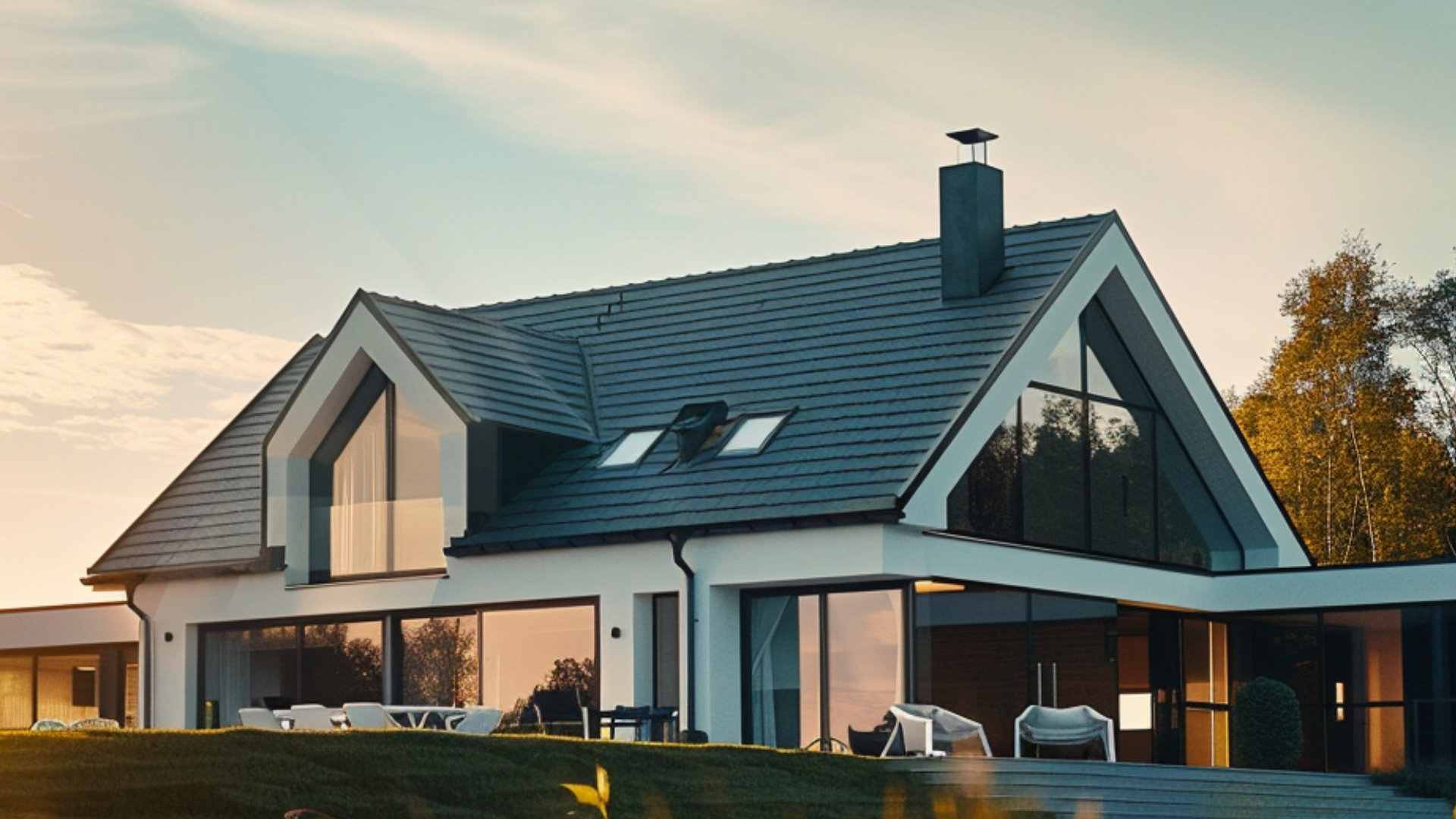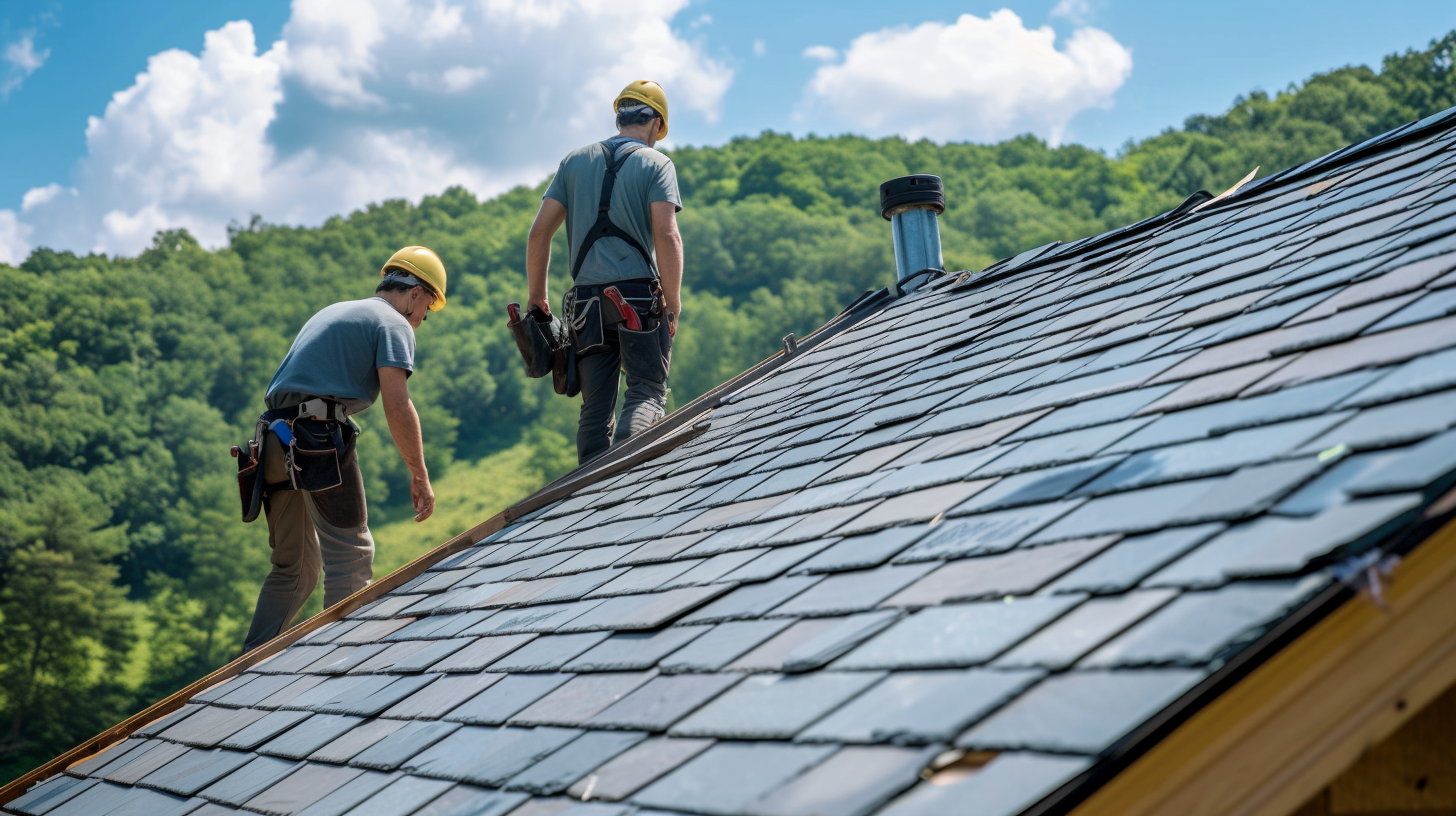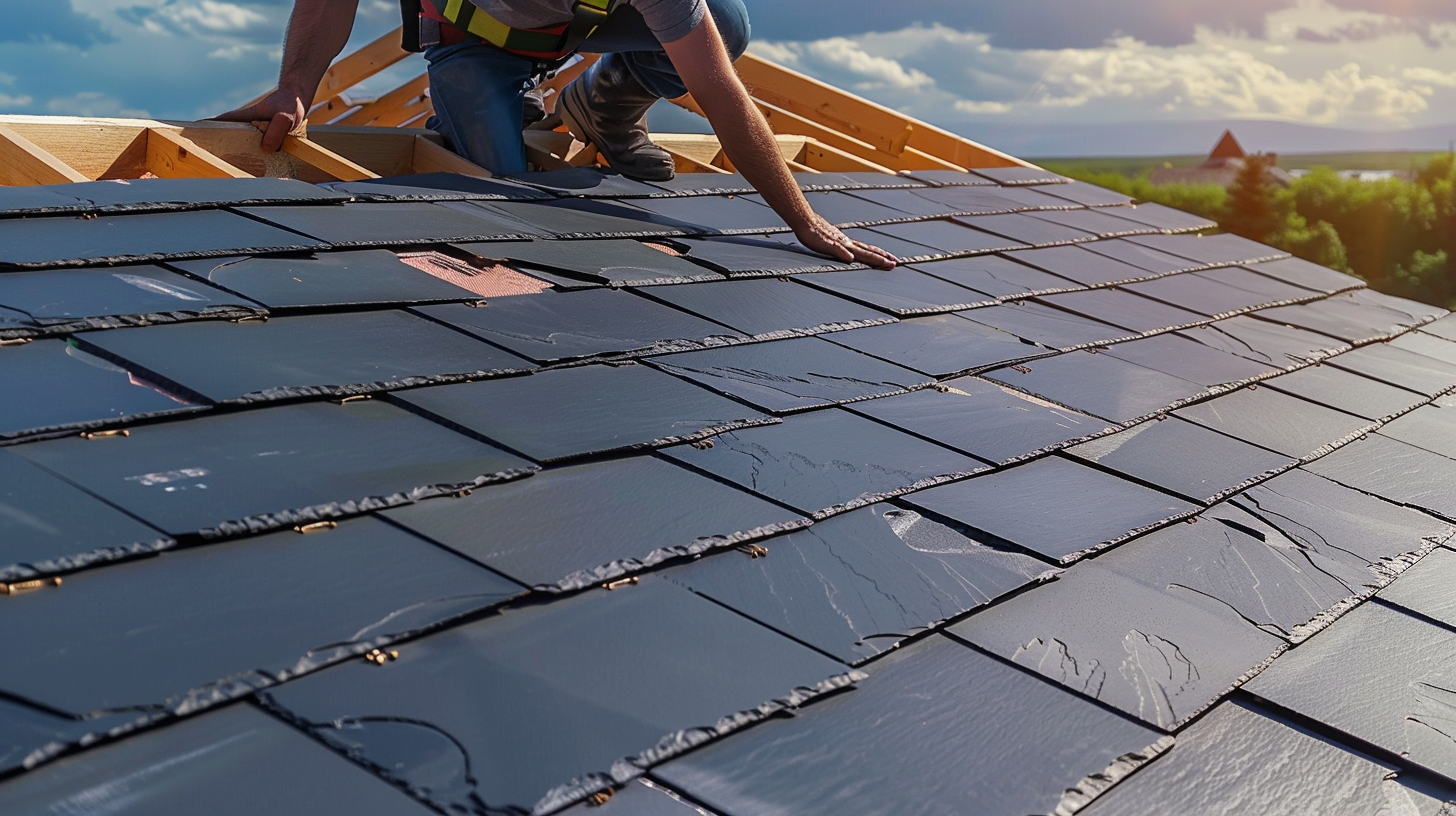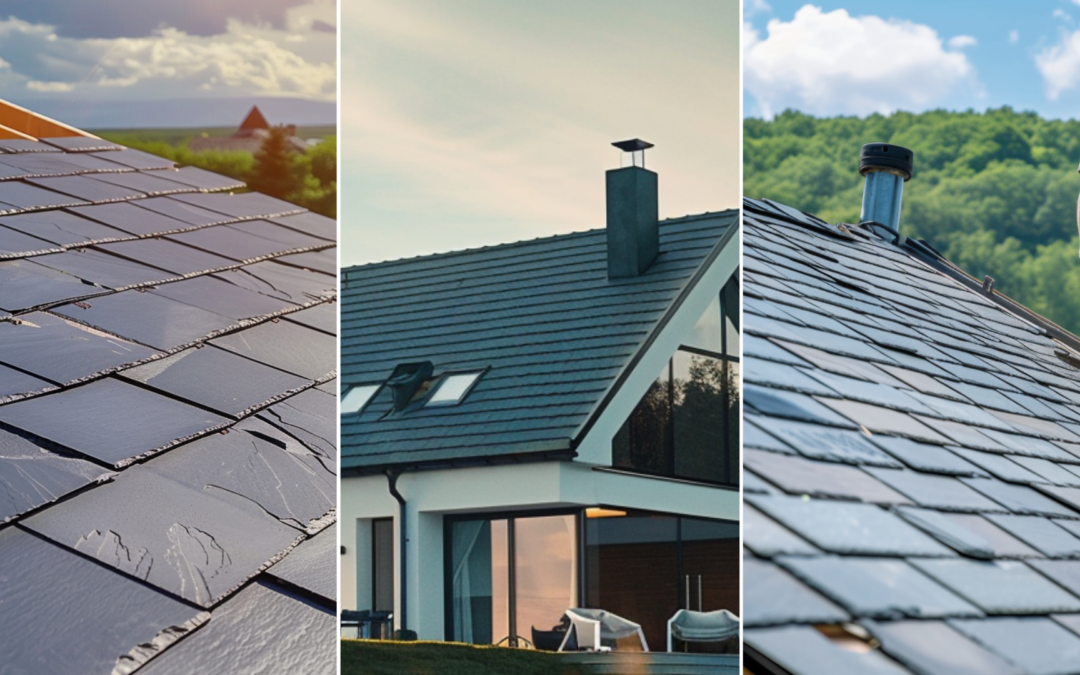Slate Roofs and Their Popularity in Roofing
Slate roofs have been a popular choice in roofing for centuries, admired by roofing contractors for their durability, timeless beauty, and unparalleled longevity. These roofs are made from natural slate stone, split into thin sheets, and then carefully layered to create a watertight barrier. Their popularity can be attributed to various factors, such as their resistance to fire, wind, and hail and low maintenance requirements. Additionally, slate roofs offer a distinctive aesthetic appeal, adding a touch of elegance and charm to any architectural style. With their ability to withstand extreme weather conditions and their long lifespan, it’s no wonder that slate roofs continue to be a sought-after option for homeowners looking for a top-quality roofing solution.

Slate Roofs - What is Slate - Sky Roofing Construction & Remodeling
Slate is a natural stone material used for centuries in roofing construction. It is formed from a combination of clay, silt, and volcanic ash that has been compressed over millions of years. Slate is known for its durability and aesthetic appeal; traditional slate roofs offer any building a timeless and elegant look. Slate is available in various colors, including black, gray, green, purple, and red, making it a versatile choice for different architectural styles. Its natural composition also provides excellent fire resistance and insulation properties, making slate roofs a practical and sustainable option for homeowners and businesses. With proper installation by an experienced contractor and regular maintenance, slate roofs can last well over a century, providing long-lasting protection and value to any property. Structural engineers often recommend a slate for its robustness, and joint slate types are frequently chosen for their reliability and appeal.

Slate Roofs - Benefits of Choosing Slate Roofs - Sky Roofing Construction & Remodeling
Benefits of Choosing Slate Roofs
Slate roofs have been a popular choice for homeowners for centuries, and for good reason. They offer a range of benefits that make them attractive for those looking for an elegant and durable roofing solution. Firstly, slate is incredibly long-lasting, with some roofs lasting well over a century. This makes it a cost-effective choice in the long run, as it requires minimal maintenance and replacement. In addition to its longevity, slate is highly fire-resistant, making it a safe option for homeowners. It is also a natural stone, which is environmentally friendly and sustainable.
Another advantage of slate roofs is their aesthetic appeal. With a wide range of colors and textures available, slate can enhance the beauty of any home, adding a touch of elegance and style. Finally, slate roofs are also highly durable and weather-resistant, able to withstand extreme heat, cold, wind, and hail. Asphalt shingles are another popular roofing material for those considering alternatives, though slate offers a different longevity and aesthetic appeal than they are. Many slate roofing systems also come with a lifetime warranty, providing homeowners with peace of mind and assurance of the roof’s lasting quality.
Slate as a Natural Material
Slate is a natural material commonly used for roofing due to its durability, aesthetic appeal, and longevity. It is a sedimentary rock that transforms into a metamorphic rock through the compression of clay or volcanic ash over millions of years. Natural slate roofing is known for its unique texture and color variations, ranging from shades of gray, blue, green, purple, and even red. This durable material offers numerous benefits for roofing applications, including its fire resistance, resistance to mold and mildew, and ability to withstand harsh weather conditions and fluctuations in temperature.
The weight of slate tiles and the realistic appearance of a textural slate roof add a touch of elegance and sophistication to any building. Proper slate installation is crucial to ensure the roof’s longevity and effectiveness. American slate, in particular, is renowned for its quality and durability, making it a preferred choice for many homeowners and architects.

Slate Roofs - Characteristics of Slate - Sky Roofing Construction & Remodeling
Slate roofs have long been famous for homeowners, celebrated for their natural beauty and exceptional durability. These roofs are characterized by their fire resistance and low maintenance requirements. Unlike other
roofing materials, slate shingles are highly resilient and withstand extreme weather conditions, making them a durable and long-lasting investment for your home.
In addition, slate is a non-combustible material, offering excellent fire resistance and providing homeowners with peace of mind. Furthermore, slate roofs require minimal maintenance compared to other roofing options, making them ideal for those seeking a hassle-free roofing solution.
Slate color varies widely, allowing for multicolored slate roofs that add a unique aesthetic to any home. However, the weight factor of slate roofing shingles means that roof decks must be strong enough to support the extra weight. Individual tiles, or roofing slates, must be installed properly to ensure the roof’s effectiveness and longevity.
Synthetic slate shingles and synthetic slate tiles are available as alternatives, offering a similar look without the extra weight. Roof edges should be carefully finished to maintain the roof’s appearance and functionality.
Slate can also be a fantastic roof option, contributing to energy efficiency. Its impressive characteristics offer homeowners a timeless and reliable roofing option, whether opting for a standard slate roof or exploring modern alternatives.
Types of Slate Roofing Materials
Slate is a popular choice for roofing materials due to its durability and timeless beauty. Slate roofs have been used for centuries and are known for their ability to withstand the test of time, making them a wise investment for homeowners. Several types of roofing materials are available, including various slate roofing materials, each with unique characteristics and advantages.
One type of slate roofing material is natural slate, mined from quarries and cut into thin, flat pieces for roof tiles. Natural slate, such as Welsh slate, is known for its natural variations in color and texture, giving each roof a one-of-a-kind look. Slate cutters and slate hammers are often used to precisely shape and install the tiles. Another type of slate roofing material is synthetic slate, which is made from a composite of recycled rubber and plastic materials. Synthetic slate offers the same aesthetic appeal as natural slate but at a lower price. Additionally, synthetic slate is lighter, making it easier to install and reducing the stress on the roof structure.
Regardless of the slate roofing material chosen, slate roofs offer several benefits. They are fire-resistant, with a high rating on fire tests, providing homeowners with peace of mind and an added layer of protection. Slate roofs are also highly durable, often lasting over a century with proper maintenance. Additionally, slate roofs are environmentally friendly, as they can be recycled and do not contribute to landfill waste.
Careful attention must be given to creating nail holes to secure the slate tiles during installation. Each row of slate must be aligned correctly to ensure the roof’s integrity. While slate roofs are among the more expensive roofing materials, their longevity, and minimal maintenance requirements can offset the initial investment. Different roof types can benefit from the slate application, offering both aesthetic appeal and functional advantages.
Natural slate is a highly sought-after roofing material known for its exceptional characteristics and impressive advantages. One key characteristic of natural slate is its high cost, primarily due to its limited supply. However, this high cost is justified by its unparalleled durability and long lifespan. Natural slate is known for its ability to withstand harsh weather conditions, making it a sturdy roofing option that can last for several decades. Also, natural slate is highly fire-resistant, providing extra safety and protection. Regarding types of natural slate, there are two main categories: hard and soft. Both have benefits and drawbacks, with challenging slates offering better durability but at a higher cost, while soft slates are more affordable but may require more maintenance.
Real Slate is a High-quality Roofing Material
Natural slate is a superior roofing material known for its durability, natural beauty, and long lifespan. Slate roofs made from natural stone have been used for centuries and continue to be a popular choice for homeowners who desire a classic and elegant look for their homes. Unlike other roofing materials, natural slate is resistant to fire, wind, and extreme weather conditions, making it a reliable and long-lasting option. Its unique texture and color variations add character to any home, giving it a timeless appeal. Additionally, the low-maintenance nature of slate roofs ensures that homeowners can enjoy their beauty without spending significant time and effort on upkeep. With proper installation and regular inspections, a natural slate roof can provide protection and beauty to a home for generations to come.
Benefits of Using Real Slate for Roofing
One of the key benefits of using natural slate for roofing is its exceptional durability and longevity. Slate is a natural material formed under intense heat and pressure, resulting in a sturdy and highly resilient roofing material. A well-maintained slate roof can last for more than a century, making it a cost-effective choice in the long run.
Natural slate roofing offers timeless elegance and beauty to a property. With its distinctive texture, subtle colors, and unique patterns, slate provides a visually appealing roof that enhances a home’s overall look and curb appeal. Whether used on a traditional or modern-style property, the natural beauty of the slate creates a sense of luxury and sophistication.
Another advantage of using natural slate for roofing is its exceptional fire resistance. Slate is a non-combustible material, offering high protection against fire damage. This makes slate roofs an excellent choice for homeowners concerned about fire safety and seeking added peace of mind.
For environmentally conscious homeowners, natural slate roofing is a sustainable and eco-friendly option. Unlike many other roofing materials that end up in landfills after a few decades, slate is a natural stone that can be recycled and reused. Its long lifespan reduces the overall environmental impact, as roof replacements require fewer materials and resources.
Natural slate tiles are a popular choice for roofing due to their numerous features and benefits. Natural slate roofs are available in hard and soft forms, with variations in cost and durability. Challenging slate tiles are more durable and tend to last longer, often having a lifespan of 75-200 years. On the other hand, soft slate tiles are less durable and have a lifespan of around 50-125 years. Regarding pricing, natural slate can range from $10 to $20 per square foot. One of the critical advantages of natural slate tiles is their exceptional durability, as they are resistant to fire and can withstand extreme weather conditions.
However, it is essential to note that natural slate is a limited resource, contributing to its higher price tag when compared to other roofing materials. Additionally, labor costs for installing natural slate roofs can be high due to the specialized skills required for proper installation. Despite the higher initial cost, natural slate roofs’ longevity and minimal maintenance requirements often make them a cost-effective investment in the long run.
Natural Slate Tiles for Roofing
Natural slate tiles are a popular choice for roofing due to their durability, beauty, and sustainability. These tiles are made from natural stone that is carefully quarried and split into thin sheets, making them lightweight yet incredibly strong. Unlike other roofing materials, natural slate tiles are naturally fire-resistant, weather-resistant, and long-lasting. In addition to their practical advantages, slate roofs have a timeless aesthetic appeal, adding a touch of elegance and sophistication to any home. Natural slate tiles come in various colors and textures, allowing homeowners to customize their roofs to suit their style. Furthermore, slate is an environmentally friendly choice as it is a natural material and can be recycled. With proper installation and maintenance, a slate roof can last a lifetime, making it a worthwhile investment for homeowners looking for a durable and stylish roofing option.
Differences Between Natural Slate Tiles and Other Roofing Materials
When choosing roofing materials, homeowners have numerous options to consider. One popular choice is natural slate tiles, which offer a range of benefits and advantages over other roofing materials. This article will explore the differences between natural slate tiles and other roofing materials, highlighting why many homeowners favor slate roofs. Multiple factors set slate roofs apart, whether the durability and longevity of slate tiles compared to other materials, their natural beauty and aesthetic appeal, or their superior weather resistance and fireproof properties. Understanding these differences can help homeowners decide when selecting the best roofing material, ensuring they enjoy a durable, attractive, and long-lasting roof for years.
Soft slate roofing offers a range of characteristics and benefits that make it a desirable choice for homeowners. With its natural appearance and rustic charm, soft slate adds a touch of elegance to any home. Compared to synthetic slate and hybrid slate options, soft slate roofing typically costs less due to its availability and the simplicity of its production process. In terms of materials, soft slate is made from natural stone, giving it a traditional and authentic look. Although soft slate is lightweight, it is still durable, offering weather resistance and fireproofing properties. Soft slate is also known for its superior beauty, as its unique textures and colors can enhance the visual appeal of a home. With its long lifespan and minimal maintenance requirements, Soft Slate is an excellent choice for homeowners looking for a practical and visually appealing roofing option.
Soft Slate and Its Use in Roofing
Soft slate is a type of natural stone used for centuries in roofing applications. With its unique properties and aesthetic appeal, soft slate is a popular choice for homeowners and contractors alike. From its durability and longevity to its ability to withstand harsh weather conditions, soft slate offers numerous benefits and advantages that make it an excellent option for those seeking a reliable and visually striking roofing material. Whether you are considering a new roof installation or looking to replace your existing one, understanding the qualities of soft slate will help you make an informed decision for your home or building.
Advantages and Disadvantages of Using Soft Slate for Roofs
Soft slate, a popular roofing material choice, offers many benefits and advantages. In terms of its benefits, soft slate is known for its durability and longevity, which can last well over a century. Additionally, soft slate is highly resistant to extreme weather conditions, making it an ideal option for areas prone to heavy rains, snowfall, and high winds. Soft slate’s natural beauty and aesthetic appeal are also worth noting, as they add a touch of elegance and sophistication to any architectural style. However, there are also a few disadvantages to consider when using soft slate for roofs. One such drawback is its higher initial cost compared to other roofing materials. Soft slate requires regular maintenance, routine inspections, and repairs to prevent cracking or chipping. Lastly, the weight of the soft slate can be a concern, as it may require additional structural support for specific buildings. Despite these challenges, the advantages of using soft slate for roofs often outweigh the disadvantages, making it a worthwhile investment for homeowners and businesses seeking a long-lasting, visually appealing roofing option.
Choose Slate Roofs for Lasting Quality
Slate roofs are a testament to durability, beauty, and longevity, making them an enduring choice for homeowners seeking unparalleled protection and aesthetic appeal. Contact Sky Roofing Construction & Remodeling today at (210) 942-9797 (https://skyroofingconstructiontx.com) to schedule your roofing consultation. Let us bring superior craftsmanship and reliable roofing solutions to your doorstep, ensuring your investment in a slate roof pays off for decades.




